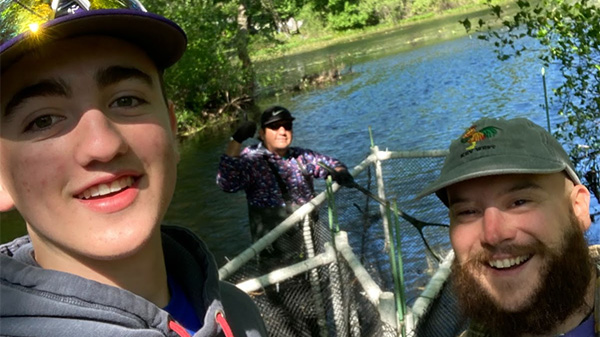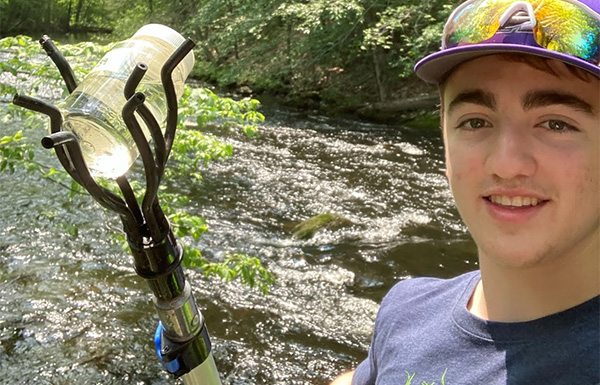
By Charlie Wortman
I am a senior at Hamden Hall Country Day School in Hamden, CT. Every senior at my school is required to complete an internship or project in the month of May, after final exams are completed. I am hoping to pursue some sort of Earth Science concentration at Brown University, which made me curious to explore opportunities at environmental organizations in Connecticut. I connected with Save the Sound and David Seigerman, the clean water communications specialist, who helped organize two weeks in May packed with a variety of activities through the work of Save the Sound and some of its partners.
My goal was to get a sense of what an organization devoted to environmental protection does in its daily life, which is why almost every day in my two-week shadowing experience focused around a different area of Save the Sound’s work. Going in, my hope was that I would have fun experiencing these myriad activities while also discovering certain roles that interest me, thus better preparing me for what I might want to pursue in my undergraduate education and my future career.
I kept a log of what I did each day. Here’s a quick look at my two weeks at Save the Sound:
Monday 5/15: I started my May internship by meeting Melissa Pappas, ecological restoration communications specialist, and her dog, Kuna, at the John S. Martinez School in New Haven, where she toured me around the new park she helped create with Save the Sound. Melissa explained that before Save the Sound’s efforts, the rain water was mixing with the trash and road salt located by the factory next to the school, which eventually ran into the Mill River as toxic runoff. The park, in addition to being eye-pleasing, works to decrease the amount of rain that enters the Mill River through natural drainage systems. I took some b-roll video footage of the park and the neighboring mural, and I also witnessed the great work of some school students picking up trash.
Tuesday 5/16, morning: Melissa showed me around the Hamden Town Center Park Rain Garden Project, where the construction crew was digging out irrigation tunnels. A green infrastructure project is underway to reduce the amount of toxic runoff that flows into the nearby river. After the drainage system, which includes different-sized rocks to filter the runoff, is put in place, about 7,000 native plants will be planted at surface level. This type of construction project is designed to make the City of Hamden more eye-pleasing and, more importantly, less harmful to the environment.
Tuesday 5/16, evening: I worked with Kathy Czepiel, lands communications specialist, at a presentation about Six Lakes Park, a project in Hamden. Justin Farmer, a member of the legislative council, along with Joe Blumberg, a resident of Whitney Center, were presenting the issue and project. I learned about the history of the land there – it formerly belonged to Winchester Ammunition (which caused more building and metal pollution in the area) – and the goals of the coalition in fixing it up to make a new nature preserve, accessible to the surrounding neighborhood. I took photos and some videos of the presentation, which took place at the Whitney Center.
Wednesday, 5/17: Jon Vander Werff, Save the Sound’s fish biologist, and his seasonal technician Nico Acuna Perales showed me around the fish trap they have in Woodbridge. I learned how it works, what they do to monitor it, and about the struggling population of the alewife, an anadromous species (which migrates up rivers from the sea) of river herring. Next, they showed me the Pond Lily Nature Preserve, where Save the Sound and partners removed the Pond Lily Dam several years ago. The river and its surrounding environment have flourished since the dam was removed, including new vegetation and wildlife. I recorded a brief interview with Jon and Nico about their roles, which will be used in a Save the Sound publication.
Thursday, 5/18: I spent the day at the CT Envirothon, an annual event where students from public and private high schools around the state come together to test their knowledge of nature. The teams took tests on various areas of the environment, including soil, forestry, and aquatics, and also gave presentations on this year’s topic of sustainable solutions to climate change. Chris Sullivan, executive director of the Southwestern Conservation District, toured me around the event, and I also helped serve lunch to the students and staffers. I also got to sit in on one of the presentations and the award ceremony. The winning team gets to go onto the international competition in Canada! It was a great experience!
Friday, 5/19: A beach cleanup planned for Saturday was rescheduled due to an inclement forecast, so I worked on my blog post.
Monday, 5/22: I went to the U.S. Forest Service building in Hamden to meet Courtney from the Southwestern Conservation District, who guided me around to collect water samples at three different locations in New Haven and Hamden. The water samples are tested for different bacteria to report on the safety of the water. All of the samples we collected were from the Mill River. After collecting the samples, we went back to the lab and set up the samples for analysis (adding substances, essentially bacteria food, and then putting them in the incubator). The samples are incubated for 24 hours, so tomorrow I will get to see which ones had bacteria present!

Tuesday, 5/23: Kathy showed me around the Save the Sound office in New Haven and introduced me to some of the staff, including someone who was a fluvial geomorphologist, which is someone who studies how rivers shape the Earth! I also helped with the Plum Island website, dedicated to promoting the goal of protecting a largely untouched island off the tip of Long Island. Plum Island was home to a federal research site for hoof and mouth disease, but now that is being moved. What remains is a mostly wild stretch of land that has incredible biodiversity. Save the Sound and its partners are working to prevent the island from being sold to a developer.
After lunch, I went back to the U.S. Forest Service lab and read the results of the samples I collected. I learned how to interpret the data and how to identify E. coli bacteria (the wells will glow if E. coli is present).
Wednesday, 5/24: I went to the Capitol and Legislative Office Building in Hartford for a Climate Day of Action. There were many advocacy groups there promoting all different kinds of agendas, from supporting non-profits to preventing gun violence to saving the environment. I attended the CT Coalition for Climate Action press conference about the environmental bills being considered in the current legislative session, and then got to talk to the senator from my district, Gary Winfield, about those bills. I took some photos for Kathy to use for Save the Sound publications. Finally, I sat in on some of the legislative sessions around the Capitol.
Thursday, 5/25: I went to a string of beaches in West Haven to take photos that may be used in the 2023 Long Island Sound Beach Report. The beaches were separated by piers and looked out upon clear, opal water. Then, I went back to the office in downtown New Haven, met some more of the staff, and worked on formatting a bibliography for the Plum Island project.
Friday, 5/26: I finished my two weeks by finishing this blog.
I really enjoyed the variety of experiences I was exposed to during my time at Save the Sound. I came into it not knowing what to expect but quickly realized how Save the Sound functions like an intricate, skillful machine. I got a glimpse into the science side (collecting water samples with an affiliate lab, monitoring fish populations), a peek at the communications work (photography, publications) and a brief look into environmental advocacy is spread, to different generations and to our lawmakers. I was pleasantly surprised at how well I was able to get a sense of the overall structure of Save the Sound, and also about how far-reaching its work really is.
From this experience, I have realized I would definitely like my career path to be at least somewhat aligned with environmental protection. I also think that I would like to gain knowledge of the science behind environmental research, but use that science to craft policy and other social change rather than be a lab worker. I can’t pinpoint one day that was necessarily my favorite because they were all so different, and that’s what made the experience so fun. But, my time at the Capitol and my time observing Jon and Nico with their fish trap were probably at the top of my list! Thank you to all of the Save the Sound staff, especially David for organizing my schedule and Kathy, with whom I spent a lot of my internship time.
Thank you to Save the Sound for allowing me to experience what goes on in an environmental action organization. And thank you to whoever is reading this for following me along my journey!
